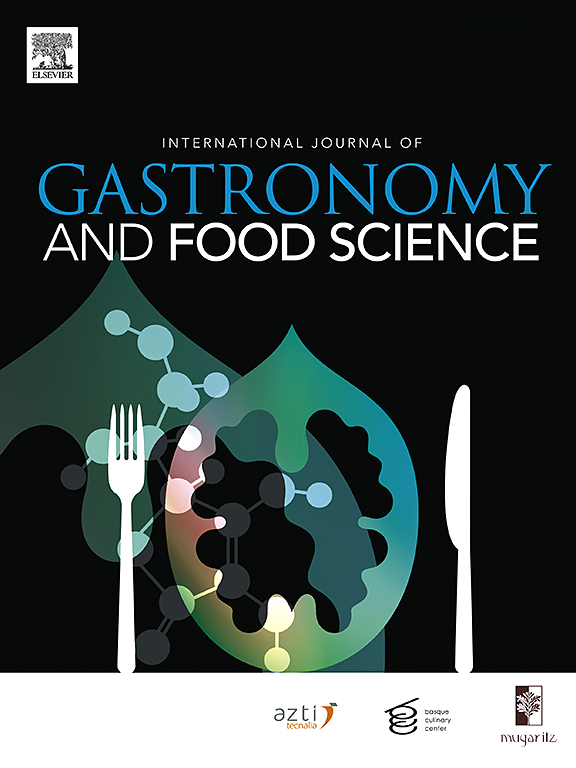基于 HS-GC-IMS 和智能感官评价的渝湘肉丝加热后品质劣变挥发性指标的鉴定
IF 3.2
2区 农林科学
Q2 FOOD SCIENCE & TECHNOLOGY
International Journal of Gastronomy and Food Science
Pub Date : 2025-04-08
DOI:10.1016/j.ijgfs.2025.101180
引用次数: 0
摘要
重新加热会扭曲准备好的菜肴的风味。以未加热的鱼香肉丝为对照,研究了微波、水浴、炒、蒸对鱼香肉丝风味的影响。采用电子鼻、电子舌、气相色谱-离子迁移谱(GC-IMS)、游离氨基酸测定等方法对YSSP的口感和香气进行综合分析。结果表明,微波处理是保存YSSP原汁原味的最有效方法。GC-IMS共检测到55种化合物,结合多元统计分析发现,环己酮、磺胺酮、乙酸异戊酯- d、芳樟醇、1-丙醇、2-甲基- d、β-蒎烯、γ-萜烯和2-戊基呋喃是再加热过程中香味扭曲的关键标志。虽然微波加热改变了风味,但与其他再加热方法相比,它仍然是保存YSSP原汁原味的最有效方法。本研究为优化再加热方法以保持预制食品原有风味提供了理论依据。本文章由计算机程序翻译,如有差异,请以英文原文为准。

Identification of volatile indicators for quality deterioration of Yu-Shiang Shredded pork after reheating based on HS-GC-IMS and intelligent sensory evaluation
Reheating can distort the flavor profiles of prepared dishes. This study investigated the effects of microwaving, water bath, stir-frying, and steaming on the flavor of Yu-Shiang Shredded Pork (YSSP), with the unheated sample as the control. The taste and aroma profiles of YSSP were comprehensively analyzed by electronic nose, electronic tongue, gas chromatography-ion mobility spectrometry (GC-IMS), and free amino acids determination. The results showed that microwaving was the most effective method in preserving the original flavor profile of YSSP. A total of 55 compounds were detected by GC-IMS, relative odor activity value combined multivariate statistical analysis revealed that cyclohexanone, sulcatone, isoamyl acetate-D, linalool, 1-propanol, 2-methyl-D, β-pinene, γ-terpinene, and 2-pentyl furan as key markers of flavor distortions during reheating. Although microwaving altered the flavor, it was still the most effective method for preserving the authentic flavor profile of YSSP compared to other reheating methods. This study provides a theoretical foundation for optimizing reheating methods to preserve the original flavor of prepared food products.
求助全文
通过发布文献求助,成功后即可免费获取论文全文。
去求助
来源期刊

International Journal of Gastronomy and Food Science
Social Sciences-Cultural Studies
CiteScore
5.30
自引率
10.50%
发文量
170
审稿时长
45 days
期刊介绍:
International Journal of Gastronomy and Food Science is a peer-reviewed journal that explicitly focuses on the interface of food science and gastronomy. Articles focusing only on food science will not be considered. This journal equally encourages both scientists and chefs to publish original scientific papers, review articles and original culinary works. We seek articles with clear evidence of this interaction. From a scientific perspective, this publication aims to become the home for research from the whole community of food science and gastronomy.
IJGFS explores all aspects related to the growing field of the interaction of gastronomy and food science, in areas such as food chemistry, food technology and culinary techniques, food microbiology, genetics, sensory science, neuroscience, psychology, culinary concepts, culinary trends, and gastronomic experience (all the elements that contribute to the appreciation and enjoyment of the meal. Also relevant is research on science-based educational programs in gastronomy, anthropology, gastronomic history and food sociology. All these areas of knowledge are crucial to gastronomy, as they contribute to a better understanding of this broad term and its practical implications for science and society.
 求助内容:
求助内容: 应助结果提醒方式:
应助结果提醒方式:


